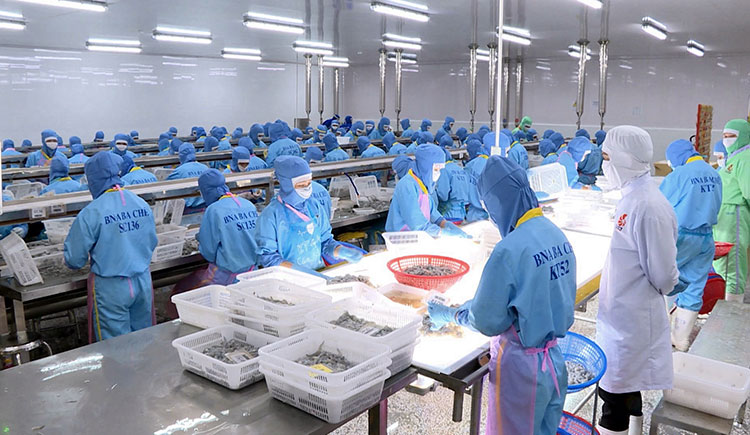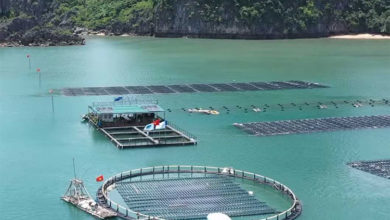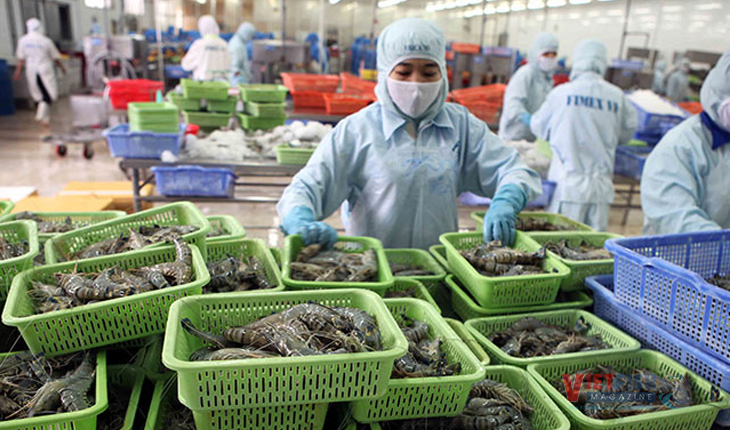Vietnam’s seafood sector adjusts market strategy amid U.S. tariff hike
Vietnamese seafood exporters are under severe pressure as the United States prepares to enforce a 46% retaliatory tariff on Vietnamese goods, effective April 9 (U.S. time).
Vietnam Association of Seafood Exporters and Producers (VASEP) confirmed that news of the steep tariff increase sparked immediate concern across Vietnam’s seafood industry.

Shrimp, tuna, and crab face market upheaval
The urgency stems from the fact that many shipments currently en route to the U.S. fall under delivery terms where Vietnamese exporters receive payment only upon final warehouse delivery. With the new tariffs looming, these businesses are deeply worried about the potential additional tax burden.
The U.S. is not only one of Vietnam’s largest seafood buyers but also plays a pivotal role in shaping global seafood trade dynamics. Annually, Vietnam exports approximately USD 2 billion worth of seafood to the U.S., accounting for around 20% of its total seafood exports.
Preliminary figures from VASEP, as of the morning of April 3, right after the tariff news broke, indicated that about 37,500 tons of seafood were already in transit to the U.S., with another 31,500 tons scheduled for shipment in May 2025. Furthermore, existing contracts for 2025 cover roughly 38,500 additional tons.
VASEP also warned that these exports could face a combined tax rate as high as 75%, once other levies such as countervailing and anti-dumping duties are factored in.
“At this stage, both the industry and exporters are waiting anxiously for updates from the government and new guidance from U.S. authorities,” VASEP remarked. VASEP added that some companies have already frozen contract negotiations and halted shipments to avoid potential breaches of agreement under the new tariff structure.
Exporters in a bind
Speaking to PLO, a shrimp exporter admitted that such high tariffs, compounded by other fees, would make it extremely challenging to compete globally.
VASEP illustrated the impact with a sobering example: a shipment of shrimp valued at USD 500,000 previously faced a 5% duty (USD 25,000). Under the new 46% tariff, this would jump to USD 230,000, an additional USD 205,000. VASEP described this as a “massive” increase.
Meanwhile, competitors like India (26%), Ecuador (10%), Indonesia (32%), and Thailand (36%) enjoy significantly lower import duties, leaving Vietnam at a disadvantage.
Tuna exporters are feeling similar strain. Already constrained by IUU fishing regulations, which have tightened raw material supplies, they now face compounding tariff burdens.
However, a major pangasius exporter expressed cautious optimism, citing market diversification as a buffer. With the U.S. accounting for 14% of their pangasius exports, the company believes it can weather the storm, even if profits take a hit.
“If the tariff goes up to 46%, we will bear higher costs, which likely means American consumers will pay more for Vietnamese pangasius,” VASEP noted. Still, they emphasized that their company has a diversified market base and isn’t solely dependent on the U.S.
Vietnam’s pangasius industry maintains inherent strengths. The country remains one of the world’s top producers, and Vietnamese pangasius tends to be more affordable than other whitefish. Nevertheless, looming raw material shortages, expected to persist until at least June, add further strain.
Call for reduced U.S. seafood tariffs
Recognizing the importance of the U.S. market, VASEP has urgently appealed to the Prime Minister and relevant ministries. The association proposed aligning the official export date with the shipment loading date, as shown on the bill of lading, to clarify tax application timelines.
In addition, VASEP advocates for lowering U.S. import duties on Vietnamese seafood and hopes the U.S. will avoid applying a flat 46% tariff across all seafood products. To strengthen its negotiating position, VASEP even suggested Vietnam reduce its current 3–10% import tax on U.S. seafood to zero.
Business leaders have backed this strategy. Tran Van Truong, CEO of Hoang Gia Seafood Chain, supports lowering U.S. seafood import duties to ease negotiations. Similarly, Doan Toi, Vice Chairman of Navico, reassured shareholders that while the U.S. is a promising market, Navico’s main focus remains on China, Brazil, the Middle East, and Asia, making the U.S. less critical to their overall strategy.
VASEP emphasized the need for businesses to stay calm and await government negotiations. Whether or not the tariff issue is resolved, she views this as a crucial lesson in market diversification. Companies need to proactively restructure and explore alternative markets. But government support is essential to ease technical barriers and unlock new trade opportunities, especially in markets like the EU and the Middle East.
BOX:
On April 5, VASEP issued fresh guidance following U.S. Customs and Border Protection (CBP) enforcement updates. Shipments en route to the U.S. before April 5 will be exempt from the additional 10% tariff if declared by May 27. Exporters are advised to retain shipping documents and bills of lading as proof.
VFM






